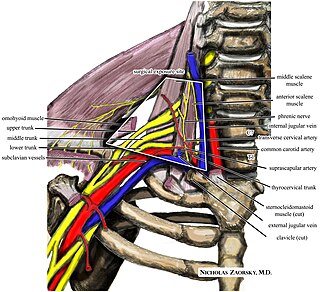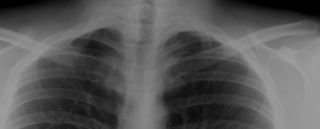
The trapezius is a large paired trapezoid-shaped surface muscle that extends longitudinally from the occipital bone to the lower thoracic vertebrae of the spine and laterally to the spine of the scapula. It moves the scapula and supports the arm.

The brachial plexus is a network of nerves formed by the anterior rami of the lower four cervical nerves and first thoracic nerve. This plexus extends from the spinal cord, through the cervicoaxillary canal in the neck, over the first rib, and into the armpit. It supplies afferent and efferent nerve fibers to the chest, shoulder, arm, forearm, and hand.

Thoracic outlet syndrome (TOS) is a condition in which there is compression of the nerves, arteries, or veins in the superior thoracic aperture the passageway from the lower neck to the armpit, also known as the thoracic outlet. There are three main types: neurogenic, venous, and arterial. The neurogenic type is the most common and presents with pain, weakness, paraesthesia, and occasionally loss of muscle at the base of the thumb. The venous type results in swelling, pain, and possibly a bluish coloration of the arm. The arterial type results in pain, coldness, and pallor of the arm.

Spondylosis is the degeneration of the vertebral column from any cause. In the more narrow sense it refers to spinal osteoarthritis, the age-related wear and tear of the spinal column, which is the most common cause of spondylosis. The degenerative process in osteoarthritis chiefly affects the vertebral bodies, the neural foramina and the facet joints. If severe, it may cause pressure on the spinal cord or nerve roots with subsequent sensory or motor disturbances, such as pain, paresthesia, imbalance, and muscle weakness in the limbs.

A Pancoast tumor is a tumor of the apex of the lung. It is a type of lung cancer defined primarily by its location situated at the top end of either the right or left lung. It typically spreads to nearby tissues such as the ribs and vertebrae. Most Pancoast tumors are non-small-cell lung cancers.

In tetrapods, cervical vertebrae are the vertebrae of the neck, immediately below the skull. Truncal vertebrae lie caudal of cervical vertebrae. In sauropsid species, the cervical vertebrae bear cervical ribs. In lizards and saurischian dinosaurs, the cervical ribs are large; in birds, they are small and completely fused to the vertebrae. The vertebral transverse processes of mammals are homologous to the cervical ribs of other amniotes. Most mammals have seven cervical vertebrae, with the only three known exceptions being the manatee with six, the two-toed sloth with five or six, and the three-toed sloth with nine.

Horner's syndrome, also known as oculosympathetic paresis, is a combination of symptoms that arises when a group of nerves known as the sympathetic trunk is damaged. The signs and symptoms occur on the same side (ipsilateral) as it is a lesion of the sympathetic trunk. It is characterized by miosis, partial ptosis, apparent anhidrosis, with apparent enophthalmos.
The white hand sign is a medical sign observed as a visible whitening of skin on the hand when the subject elevates the hands above the shoulder girdle with fingers pointing to the ceiling and palms facing forward. It results from this change in position causing a compression of the subclavian artery and temporary loss of circulation, as often occurs in patients with thoracic outlet syndrome, a complex syndrome involving the compression of various nerves and blood vessels between the axilla (armpit) and the base of the neck.

A cervical rib in humans is an extra rib which arises from the seventh cervical vertebra. Their presence is a congenital abnormality located above the normal first rib. A cervical rib is estimated to occur in 0.2% to 0.5% of the population. People may have a cervical rib on the right, left or both sides.
In medicine, physiotherapy, chiropractic, and osteopathy the hip examination, or hip exam, is undertaken when a patient has a complaint of hip pain and/or signs and/or symptoms suggestive of hip joint pathology. It is a physical examination maneuver.

Brown-Séquard syndrome is caused by damage to one half of the spinal cord, i.e. hemisection of the spinal cord resulting in paralysis and loss of proprioception on the same side as the injury or lesion, and loss of pain and temperature sensation on the opposite side as the lesion. It is named after physiologist Charles-Édouard Brown-Séquard, who first described the condition in 1850.

Ulnar nerve entrapment is a condition where the ulnar nerve becomes physically trapped or pinched, resulting in pain, numbness, or weakness, primarily affecting the little finger and ring finger of the hand. Entrapment may occur at any point from the spine at cervical vertebra C7 to the wrist; the most common point of entrapment is in the elbow. Prevention is mostly through correct posture and avoiding repetitive or constant strain. Treatment is usually conservative, including medication, activity modification, and exercise, but may sometimes include surgery. Prognosis is generally good, with mild to moderate symptoms often resolving spontaneously.
A GALS screen is an examination used by doctors and other healthcare professionals to detect locomotor abnormalities and functional disability relating to gait, arms, legs and the spine.
The Spurling test is a medical maneuver used to assess nerve root pain. The examiner turns the patient's head to the affected side while extending and applying downward pressure to the top of the patient's head. A positive Spurling's sign is when the pain arising in the neck radiates in the direction of the corresponding dermatome ipsilaterally. It is a type of cervical compression test.
Alfred Washington Adson was an American physician, military officer, and surgeon. He was in medical practice with the Mayo Clinic and the Mayo Graduate School of Medicine of the University of Minnesota at Rochester, Minnesota. He was associated with the development of the Section of Neurological Surgery which was first established at Mayo in 1919. He functioned as its chair until 1946. He undertook pioneering neurosurgery and gave his name to a medical condition, a medical sign, a medical diagnostic manoeuvre, and medical instruments.
Wright's test is a clinical sign in which the radial pulse weakens or disappears when the arm is abducted and externally rotated. It occurs in some patients with thoracic outlet syndrome.

Spinal stenosis is an abnormal narrowing of the spinal canal or neural foramen that results in pressure on the spinal cord or nerve roots. Symptoms may include pain, numbness, or weakness in the arms or legs. Symptoms are typically gradual in onset and improve with leaning forward. Severe symptoms may include loss of bladder control, loss of bowel control, or sexual dysfunction.
A shoulder examination is a portion of a physical examination used to identify potential pathology involving the shoulder. It should be conducted with both shoulders exposed to assess for asymmetry and muscle wasting.

Forward head posture (FHP) is an excessively kyphotic (hunched) thoracic spine. It is clinically recognized as a form of repetitive strain injury. The posture can occur in dentists, surgeons, and hairdressers, or people who spend time on electronic devices. It is one of the most common postural issues. There is a correlation between forward head posture and neck pain in adults, but not adolescents.
Pectoralis minor syndrome (PMS) is a condition related to thoracic outlet syndrome (TOS) that results from the pectoralis minor muscle being too tight. PMS results from the brachial plexus being compressed under the pectoralis minor while TOS involves compression of the bundle above the clavicle. In most patients, the nerves are constricted resulting in neurogenic PMS, but venous compression can also occur. PMS and TOS often, but not always, occur together. They share similar symptoms including tingling, pain, or weakness in the hand and arm, but in PMS there is also pain or tenderness in the chest wall where the pectoralis minor attaches to the scapula as well as in the armpit. One study of 100 patients diagnosed with neurogenic TOS found that 75 percent also had neurogenic PMS and 30 percent in fact had PMS without TOS.











